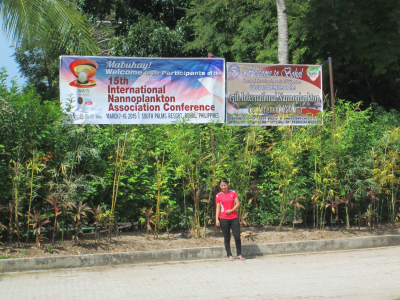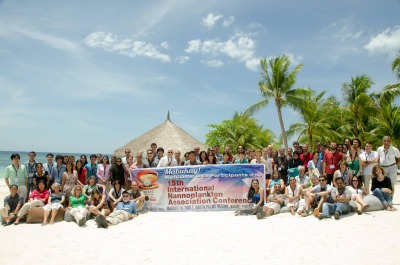Die Inhalte dieser Seite sind leider nicht auf Deutsch verfügbar.
Seitenpfad:
Deborah Tangunan
Report of GLOMAR PhD student Deborah Tangunan about her participation in the 15th International Nannoplankton Association (INA) Meeting in Bohol, Philippines from 7 - 16 March 2015
Where else is the best venue to talk about marine organisms? I guess, there is no other place than beside their home.
The 15th International Nannoplankton Association (INA) Meeting was held at a beach resort in Bohol Island, Philippines. The INA meeting, which happens every two years, is a gathering of scientists, researchers, and students around the world who specialize in calcareous nannoplankton. About a hundred participants from Asia, Europe, and the United States attended the conference. The scientific community working on calcareous nannoplankton is quite small and intimate. All the senior researchers and scientists know one other, with new faces, either new MS/PhD students or new researchers, only adding up to the community every meeting.
I was able to attend and listened to almost all the talks in all the seven sessions during the conference. It is really hard to miss a talk since all of them are interesting and in one way or another, can contribute to my research. While my field of interest and my PhD work is related to sessions V (Paleoclimate studies) and VI (Paleoceanography and paleoenvironment studies), I was also interested in the talks on taxonomy and evolution, biostratigraphy, and Recent calcareous nannoplankton. Aside from the talks, there were three parallel workshops to choose from: two workshops on biostratigraphy and one on extant coccolithophores. I opt to attend the workshop on the “Biogeography and ecology of extant coccolithophores: floristic similarities/differences among oceans” organized by Dr. Kyoko Hagino, Dr. Jeremy Young, and Dr. Karl-Heinz Baumann.
While I have gained new knowledge from listening to the talks and attending the workshop, I also had my time discussing and sharing my work with my fellow participants through the poster session. I presented a poster entitled, “Response of coccolithophores to paleoproductivity changes in the western tropical Indian Ocean (off Tanzania, East Africa) for the past 25kyrs”. There were three 1-hour poster sessions and each time, all the poster presenters stood beside their respective poster. During one of the poster sessions, I was able to talk to Dr. Luc Beaufort, the person I was waiting to discuss my poster with because he had written several papers on the Indian Ocean productivity reconstruction. I will be using his equation on the calculation of primary productivity from the relative abundance of a calcareous nannoplankton species and will compare this with his data from one of the Indian Ocean cores that he worked on. He provided valuable insights and suggestions on how to continue on with my research.
I have also enjoyed the discussions I had with my fellow PhD students and researchers. Through these discussions, I gained a broader and wider knowledge about my field and my PhD work. Some of them even suggested methods/ techniques to help me in answering my PhD research questions. Since I have just started with my PhD, all these insights and suggestions are beneficial in the advancement of my project.
I feel really fortunate to be able to participate in this conference, even luckier because the conference was held in the Philippines, my home country. I was also very happy that everyone loved the beach venue, where most of the participants can just literally plunge into the water during lunch breaks. For people coming from countries experiencing winter, the conference is the best opportunity for an early experience of the warm, welcoming heat of the sun.
All in all, I have gained a lot of things from this conference- new insights, techniques, and updates on calcareous nannoplankton studies that I can use in my research. Moreover, the ties that I built with the experts in this field and with my fellow PhD students extended my scientific network and professional contacts across the globe.
The 15th International Nannoplankton Association (INA) Meeting was held at a beach resort in Bohol Island, Philippines. The INA meeting, which happens every two years, is a gathering of scientists, researchers, and students around the world who specialize in calcareous nannoplankton. About a hundred participants from Asia, Europe, and the United States attended the conference. The scientific community working on calcareous nannoplankton is quite small and intimate. All the senior researchers and scientists know one other, with new faces, either new MS/PhD students or new researchers, only adding up to the community every meeting.
I was able to attend and listened to almost all the talks in all the seven sessions during the conference. It is really hard to miss a talk since all of them are interesting and in one way or another, can contribute to my research. While my field of interest and my PhD work is related to sessions V (Paleoclimate studies) and VI (Paleoceanography and paleoenvironment studies), I was also interested in the talks on taxonomy and evolution, biostratigraphy, and Recent calcareous nannoplankton. Aside from the talks, there were three parallel workshops to choose from: two workshops on biostratigraphy and one on extant coccolithophores. I opt to attend the workshop on the “Biogeography and ecology of extant coccolithophores: floristic similarities/differences among oceans” organized by Dr. Kyoko Hagino, Dr. Jeremy Young, and Dr. Karl-Heinz Baumann.
While I have gained new knowledge from listening to the talks and attending the workshop, I also had my time discussing and sharing my work with my fellow participants through the poster session. I presented a poster entitled, “Response of coccolithophores to paleoproductivity changes in the western tropical Indian Ocean (off Tanzania, East Africa) for the past 25kyrs”. There were three 1-hour poster sessions and each time, all the poster presenters stood beside their respective poster. During one of the poster sessions, I was able to talk to Dr. Luc Beaufort, the person I was waiting to discuss my poster with because he had written several papers on the Indian Ocean productivity reconstruction. I will be using his equation on the calculation of primary productivity from the relative abundance of a calcareous nannoplankton species and will compare this with his data from one of the Indian Ocean cores that he worked on. He provided valuable insights and suggestions on how to continue on with my research.
I have also enjoyed the discussions I had with my fellow PhD students and researchers. Through these discussions, I gained a broader and wider knowledge about my field and my PhD work. Some of them even suggested methods/ techniques to help me in answering my PhD research questions. Since I have just started with my PhD, all these insights and suggestions are beneficial in the advancement of my project.
I feel really fortunate to be able to participate in this conference, even luckier because the conference was held in the Philippines, my home country. I was also very happy that everyone loved the beach venue, where most of the participants can just literally plunge into the water during lunch breaks. For people coming from countries experiencing winter, the conference is the best opportunity for an early experience of the warm, welcoming heat of the sun.
All in all, I have gained a lot of things from this conference- new insights, techniques, and updates on calcareous nannoplankton studies that I can use in my research. Moreover, the ties that I built with the experts in this field and with my fellow PhD students extended my scientific network and professional contacts across the globe.




